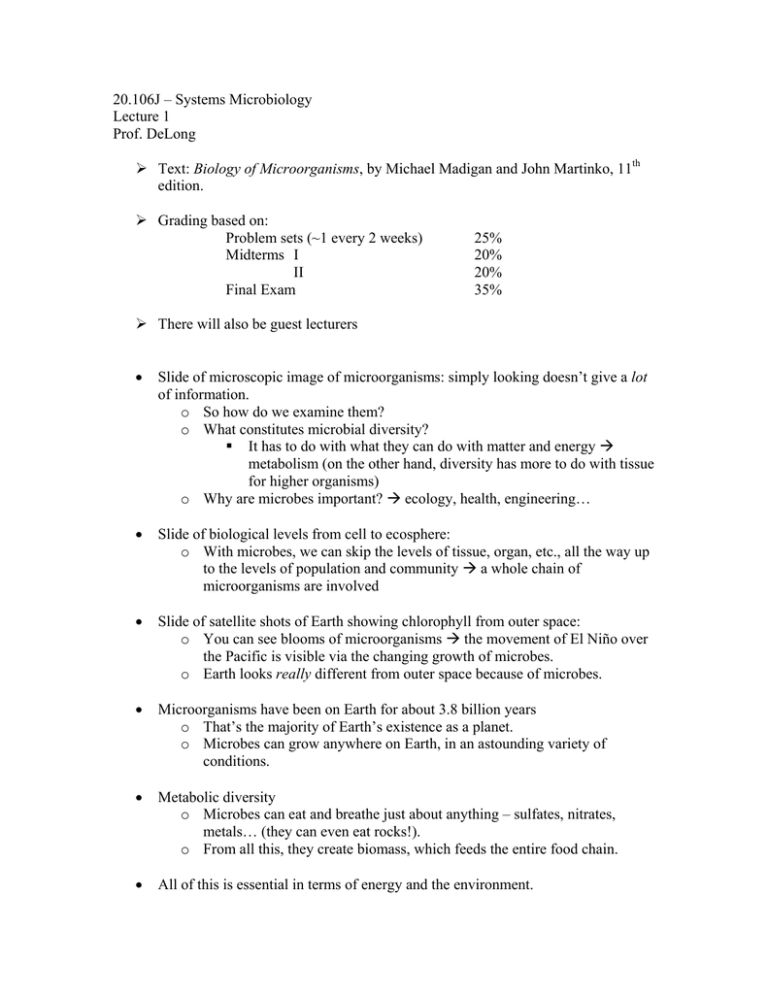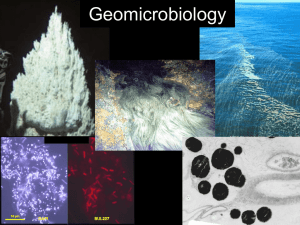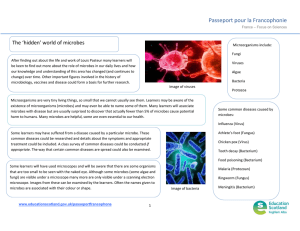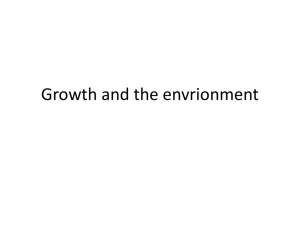20.106J – Systems Microbiology Lecture 1 Prof. DeLong
advertisement

20.106J – Systems Microbiology Lecture 1 Prof. DeLong ¾ Text: Biology of Microorganisms, by Michael Madigan and John Martinko, 11th edition. ¾ Grading based on: Problem sets (~1 every 2 weeks) Midterms I II Final Exam 25% 20% 20% 35% ¾ There will also be guest lecturers • Slide of microscopic image of microorganisms: simply looking doesn’t give a lot of information. o So how do we examine them? o What constitutes microbial diversity? It has to do with what they can do with matter and energy Æ metabolism (on the other hand, diversity has more to do with tissue for higher organisms) o Why are microbes important? Æ ecology, health, engineering… • Slide of biological levels from cell to ecosphere: o With microbes, we can skip the levels of tissue, organ, etc., all the way up to the levels of population and community Æ a whole chain of microorganisms are involved • Slide of satellite shots of Earth showing chlorophyll from outer space: o You can see blooms of microorganisms Æ the movement of El Niño over the Pacific is visible via the changing growth of microbes. o Earth looks really different from outer space because of microbes. • Microorganisms have been on Earth for about 3.8 billion years o That’s the majority of Earth’s existence as a planet. o Microbes can grow anywhere on Earth, in an astounding variety of conditions. • Metabolic diversity o Microbes can eat and breathe just about anything – sulfates, nitrates, metals… (they can even eat rocks!). o From all this, they create biomass, which feeds the entire food chain. • All of this is essential in terms of energy and the environment. The vast amount of diversity on Earth exists in the microbial world. Microbes represent more than 50% of biomass in the oceans. They control all the elemental cycles that shape Earth’s habitability. They can live without us… but we can’t live without them. It used to be that microbes were the only way that nitrogen got into the atmosphere… But now, with fertilizers etc., people are contributing to the nitrogen cycle more than microbes are. o Slide: photosynthesis and respiration Plants ÅÆ Animals: both are codependent o Slide: Energy: The Anthropocentric perspective We’re using up all the oil, putting carbon dioxide in the atmosphere. o Slide: graph of atmospheric carbon dioxide over time, as measured at Mauna Loa. Shows a steep, steady increase – we haven’t seen an increase like this in a very long time – it doesn’t look natural. There are spikes of carbon dioxide every winter and lower areas every summer, because plants are photosynthesizing more in the summer. This increase in carbon dioxide could have serious consequences as the greenhouse gas effect. o o o o o • Slide: “The Popular View of ‘Bugs’” o People popularly think that microbes (“bugs”) are somehow dirty or damaging, but the truth is that you cannot get rid of them – they’re all over your body, and most of them are good for you. It’s a symbiotic relationship. Slide: host bacterial symbiosis in the human intestine. • Fundamentally, pathogenic microorganisms use the same machinery as nonpathogenic ones. o Short movie: bacteriophage infecting a cell. • Biotechnology and biological engineering: research examples o Functional diversity in rhodopsin – in the presence of light, this will move a proton, creating an electrical gradient that allows ATP production o The functional parts of a cell: people are working on creating a registry of standard biological parts. • Life on Earth: How did we (everything) get here? (Lessons in geobiological engineering). o Microbes seem to have originated about 3.8 billion years ago. o But it turns out that the oldest rocks on Earth are only about 4 billion years old (existing in Greenland, Australia, and South Africa). o Slide: “The Early Earth System,” “The Evidence” o It’s hard to make all these inferences, because the earth looks so different now The early earth had no oxygen, water only as steam, and lots of asteroid collisions. o The origin of life on Earth: In situ (originating here) or panspermia (coming from elsewhere via a collision) • Panspermia seems unlikely, though interesting, because outer space can destroy these organic molecules very quickly. The Oparin ocean scenario, or hydrothermal vents? o Determining the atmospheric composition of the early earth is still largely guesswork This early atmosphere had mildly reducing conditions As the earth cooled, H20 dropped from the sky, and the oceans formed. These early oceans contained lots of sulfates and acids. • Some scenarios for the origin of life: o The Miller Urey experiment: CH4, H2, NH4, and H2O, plus energy, will generate amino acids and simple sugars. o But how do you produce molecules that actually replicate? Slide: ribosomal RNA – its folding, tertiary structure allows it to act as an enzyme: ribozyme. Thus we have a single molecule that can reproduce itself and act as an enzyme, and hence this might be where life originated There’s also a clay that can create lipids, and once one of these ribozymes ended up inside one of these lipid vesicles, very interesting things could happen. However, there are some problems – we don’t really know – this is all speculative. • The evidence for theories on the origin of life: o People look at very old rocks, and identify impressions that look like life, starting around 3.5 billion years back. Microbes create macrofossils – stromatolites – microbial mats that create layers, building formations that look like big rock mushroom structures. • Stable isotope analysis, organic geochemistry. o Look at the internal structure of an atom – there are different isotopes. o We know the normal stable isotope abundances. o Life changes these isotope abundances, because it uses light isotopes preferentially. o The delta value δ – comparing isotope ratios – measure using mass spectroscopy. ⎛ R X − R Std ⎞ 0 ⎟⎟ (per mil) 00 R std ⎝ ⎠ o We breathe out more heavy oxygen than we take in o In plants, they preferentially incorporate the lighter carbon dioxide as well o All of this matters because we can measure the isotope ratios in fossils – old rocks – and they’re really light! This kind of chemical evidence is a lot more reliable than just examining these rocks visually – this is real evidence. δ X = 1000⎜⎜ • Around 2.5 billion years ago something big happened, dropping huge amounts of oxidized iron – rust – into the earth in huge red bands Æ this represents the rise of oxygen in the atmosphere, as microbes and plants figured out how to split water. o That rise in oxygen is what set the stage for us – animals.







